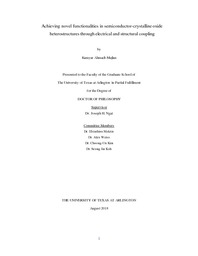| dc.description.abstract | Creating new materials that exhibit enhanced or novel behaviors is essential to meet the technological challenges we face today. Complex oxides are perfect candidates to overcome these challenges due to the range of electronic, optical, and ionic properties they exhibit. The research presented here, mainly focuses on overcoming two important challenges in oxide electronics. First,the ability of epitaxially growing multifunctional oxides on conventional semiconductor substrates and second, the successful integration of multifunctional oxide properties on semiconductors Oxide molecular beam epitaxy was utilized to grow transition metal oxides with unprecedented control, layer-by-layer, at the atomic scale. Such control of growth enables oxides differing in chemical composition and functionality to be epitaxially combined in artificial heterostructures. By manipulating the composition and functionality, artificial heterostructures can potentially be designed to exhibit enhanced or new behaviors not found in bulk compounds. In this regard, the work presented here consists of three individual research projects in which each project has tried to integrate some of the functionalities of transition metal oxides into semiconductors for possible future device applications.1. Project one: Band gap engineering at a crystalline oxide-semiconductor interface.• M.J. Moghadam et. al. Advanced Materials Interfaces, 2, 140049, (2015).Project two: Superconducting YBa₂Cu₃O₇-δ grown epitaxially on SrTiO₃ buffered Si (001).• K Ahmadi-Majlan et. al. Journal Bulletin of Materials Science, 41, 23, (2018). VProject three: Tuning the metal-insulator transition in LaTiO₃/SrTiO₃ heterostructures integrated on Si (001).• Kamyar Ahmadi-Majlan et. al. Applied Physics Letters, 112, 193104, (2018).Band-gap engineering at a semiconductors-crystalline oxide interface.Complex oxide materials exhibit a wide range of properties such as magnetism,superconductivity, ferroelectricity and multiferroicity that are needed to create new functionalities and to address various challenges in energy harvesting and microelectronics. One way of creating new materials is to combine materials that exhibit dissimilar behaviors and try to electrically couple them. Oxides and semiconductors are two classes of materials with different properties.Combining them electrically may make it possible to create functionalities that cannot be realized in either material alone. In this regard, the main objective of the first part of this thesis is to achieve novel material functionalities by electrically coupling multifunctional oxides on to conventionalsemiconductors. Principles of band gap engineering were applied to change the band offset from Type-II to Type-I to create an electrical platform in which the conduction (valence) band of semiconductors is below (above) the conduction (valence) band of oxide. The system that we have explored is a solid solution of SrZrxTi1-xO₃ on a Ge substrate.Various structural characterization techniques such as: X-ray diffraction measurements and scanning transmission electron microscopy confirm an atomically abrupt and structurally coherent interface between SrZrxTi1-xO₃ and Ge. Moreover, electrical characterizations like, current-voltage and capacitance-voltage measurements indicate that Type-I band offset has been achieved. Finally, X-ray photoemission spectroscopy was used to measure the band offset between the epitaxial oxides grown on Ge substrate. VI Superconducting epitaxial YBa₂Cu₃O₇-δ on SrTiO₃ buffered Si (001)The changes in technology along with the increased demand for effective electronic devices has prompted researchers to search for novel materials having new properties with the intention of creating faster and more reliable technologies. It has been indicated that the complex transition metal oxides exhibit exotic properties and are thus regarded as a likely choice for future electronic applications. Properties such as ferroelectricity, magnetism and superconductivity can be integrated into oxide-semiconductor heterostructures for device applications like microelectronic,sensing and energy harvesting technologies.One of the most interesting and technologically relevant properties of complex transition metal oxides is superconductivity in which transition metal oxides exhibit zero resistance below a transition temperature. In the second part of the thesis, the effect of a single crystalline SrTiO₃ buffer layer on the transport properties of YBa₂Cu₃O7-δ grown epitaxially on silicon was investigated. Single crystalline SrTiO₃ grown epitaxially on silicon using oxide molecular beam epitaxy is proven to be a reliable platform to integrate superconducting YBa₂Cu₃O₇-δ films. The stability of SrTiO3 on silicon under ambient conditions without any protective layer makes it an ideal candidate to be used as platform for other deposition techniques like sputtering, which enables growth of YBa₂Cu₃O₇-δ on a larger size wafer. The single crystalline YBa₂Cu₃O₇-δ grown on SrTiO₃ buffered silicon exhibits higher Tc (93 K) as confirmed by transport measurement.Tuning metal-insulator behavior in LaTiO₃/SrTiO₃ heterostructures integrated directly on Si (100) through control of atomic layer thickness.Transition metal oxides that exhibit strongly correlated phenomena are of great interest due to their unique properties such as strong electron-electron correlation, high carrier density,superconductivity and magnetism which can be utilized in new electronic devices. The ability of VII growing oxide heterostructures with atomic level precision utilizing oxide molecular beam epitaxyenables us to introduce strong electron-electron correlation phenomena at the interface through varying the thickness of oxide layers and manipulating the electronic stability of heterostructures. In the fourth chapter of this thesis, electrical and structural characterization of metal-insulator behavior in oxide heterostructures integrated directly on silicon were demonstrated.The heterostructures that we have explored consist of a wide band gap insulating SrTiO₃ and Mott insulator LaTiO₃ epitaxially grown on un-doped Si (001). Scanning transmission electronmicroscopy images confirm atomically abrupt and coherent interface in the heterostructures in which reducing the thicknesses of the SrTiO₃ layer sandwiched between LaTiO₃ and silicon results in a metal insulator transition through enhancement of carrier-carrier scattering. The metallic side of the transition can be explained by Fermi-Liquid behavior and the insulating behavior can be described by activated transport. According to the data presented in this document, the metal insulator transition observed in LaTiO₃/SrTiO₃ heterostructure is consistent with the transition through filling control mechanism. | |


